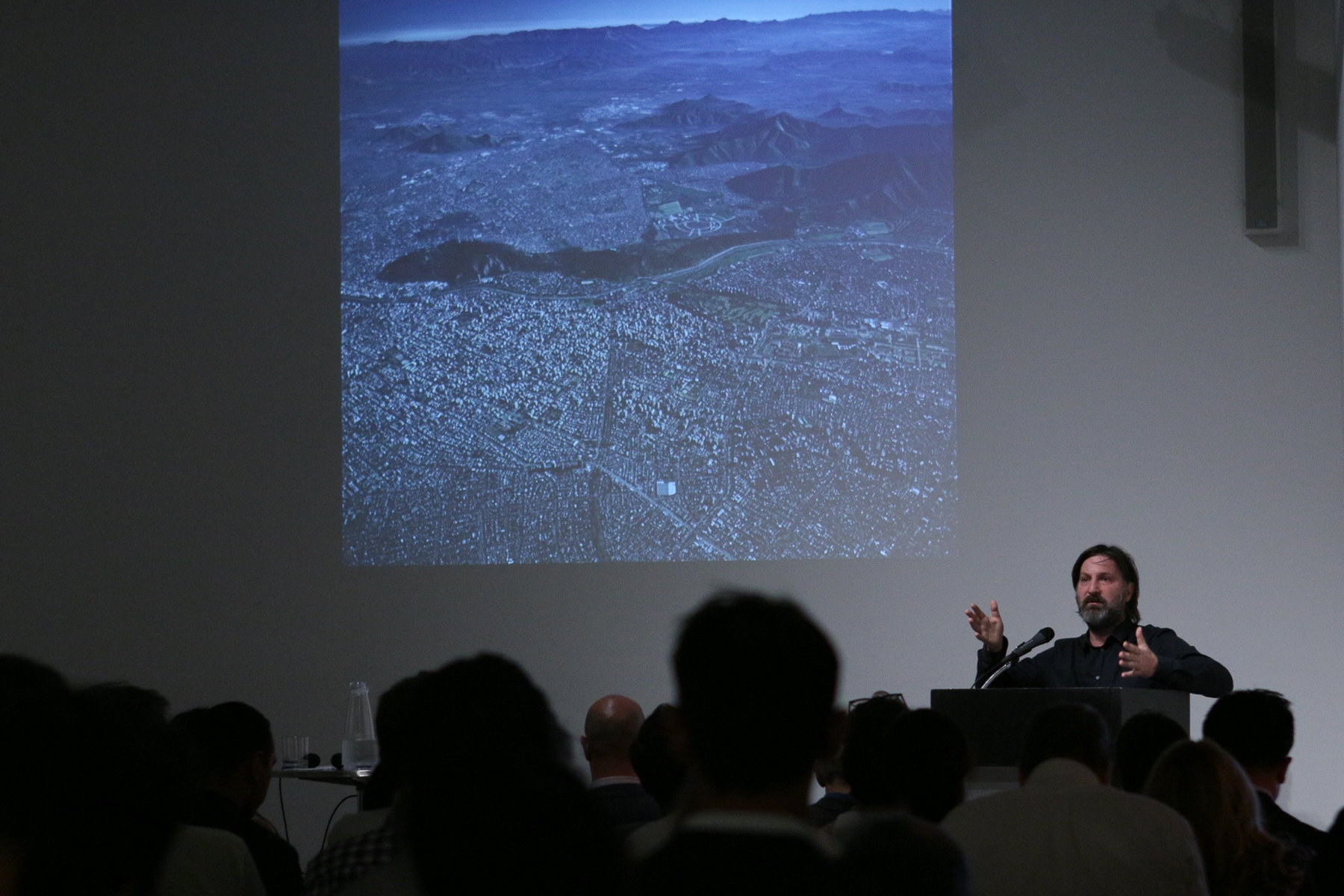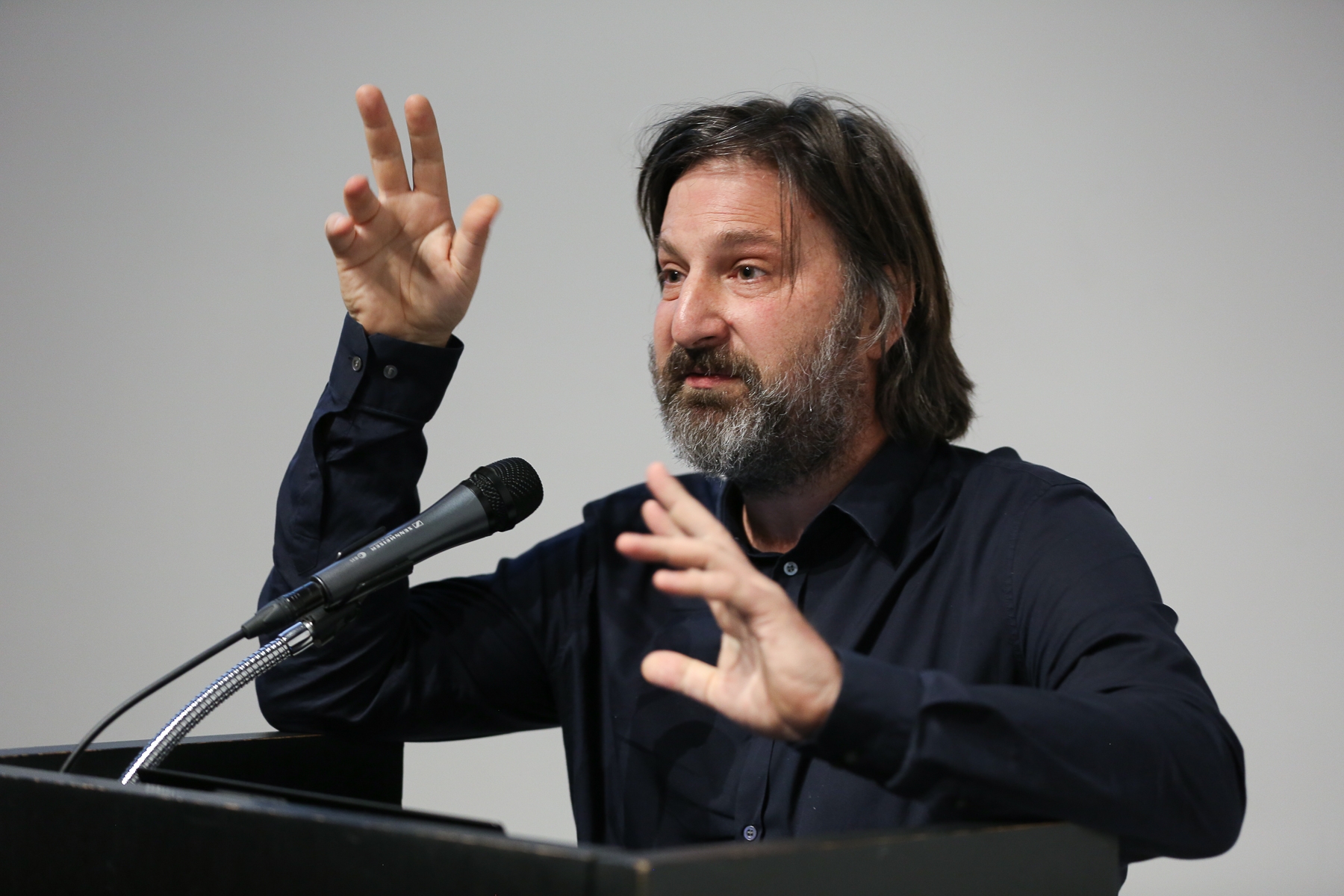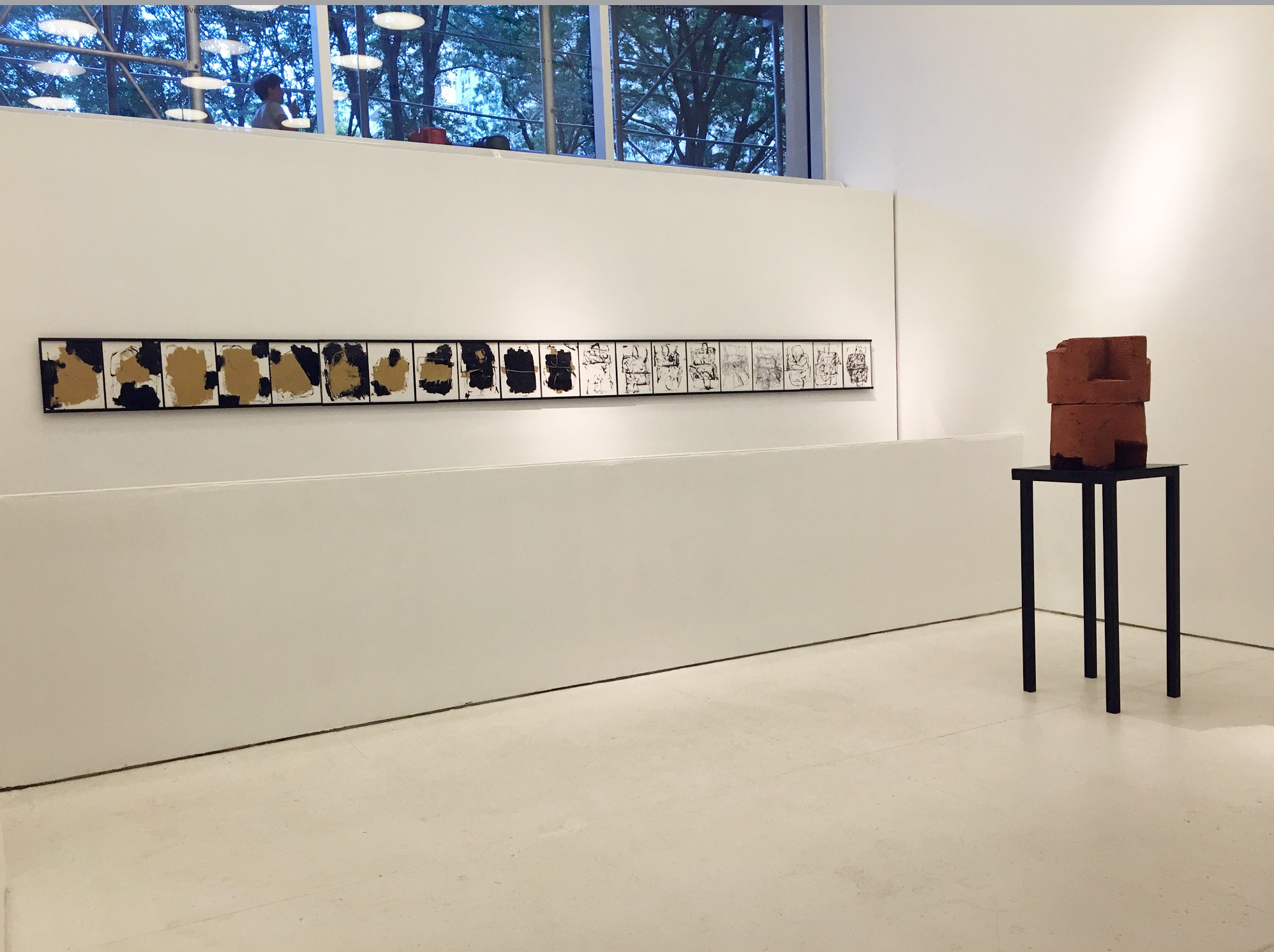by Cynthia Kracauer
As part of our opening festivities for “EXTRA-ORDINARY: New Practices in Chilean Architecture,” on view through mid-September, Smiljan Radic presented insights into his very personal creative process that includes material, contextuality, image, memory, history, technology, and conviction.
“EXTRA-ORDINARY” also features the work of 14 other Chilean architects: Alejandro Aravena, Guillermo Acuña, Aguiló + Pedraza, José Cruz, 57 Studio, GUN, Hevia + Urzúa, Sebastián Irarrázaval, Cristián Izquierdo, Mathias Klotz, Pedro Kovacic, Max Núñez, Cristián Olivi, and Pezo von Ellrhichshausen. Radic has a special place in the exhibition: a single original model, “Death at Home,” along with 20 associated ink drawings. The installation has the immediacy of the hand of the artist; it is original material, and suitably cryptic.
Following a brief introduction by “EXTRA-ORDINARY” curator Jeannette Plaut, Radic’s first slide appeared – a drawing of a gryphon, and vaguely familiar – one of Sir John Tenniel’s illustrations from Alice’s Adventures in Wonderland. As Radic came to the podium and settled in, we knew we were in for a trip through the looking glass. Radic is Alice, his Wonderland filled with selfish ogres, boys trapped in barnacle-encrusted stones, and remote princesses high atop wineglass towers.
I did not anticipate how taken I would be with him and his work. Radic does not have a website, and prior to the exhibition, the work most familiar to me was the 2014 Serpentine Pavilion in London’s Hyde Park. Serpentine Gallery Co-director Julia Peyton-Jones referred to as “an alien space pod that has come to rest on a Neolithic site.” The structure was sold and relocated to the Hauser & Wirth Somerset gallery, sited in a field of gently blowing wildflowers. It is within easy driving distance to Salisbury, close to the brooding ritual landscapes of Stonehenge, Woodhenge, the Cursus, and Late Bronze Age barrow cemeteries – actual Neolithic sites.
Radic’s grandfather came to Chile from Brac, an Adriatic island off Croatia, in 1919. Perhaps the turmoil of the Great War, and the new multi-ethnic kingdom called for exile or opportunity. I am speculating. Radic writes: “The vision of an immigrant moves between a sense of estrangement from the surrounding world and a need to see things from a productive standpoint, the making of objects, situations, and memories takes on a new unexpected dynamic. In this way I still try to consider myself an immigrant.” This is the sense we get with his work – slightly strange in the world, out of time.
The Pinochet coup took place when Radic was eight years old. The military dictatorship lasted until 1990. During this time, there was something of a global “blackout” in Chile, according to Plaut. The political situation proscribed adventuresome architectural speculation.
Radic received his architectural degree from the School of Architecture at the Pontificia Universidad Católica de Chile in 1989. He went on to study aesthetics at the Instituto Universitario di Architettura di Venezia. Manfredo Tafuri was there dying, and, as Radic described, a bit “grey in the face.” When he shows a huge Andean boulder arriving by barge for the 2010 Venice Biennale, he notes the time and distance traveled by both the 19-ton stone and himself. Contemplating the 2010 Chilean earthquake, Radic creates a refuge, a place of calm from the “fluxus of the visitors.” To elucidate this notion, he retells the fable by Oscar Wilde, “The Selfish Giant.” It is a redemption story.
His presentation on the Bienniale installation layered images from the unconscious, from a Grimm fairy tale (“The Sea Hare”), and, at a second remove, illustrations for the tales by David Hockney. Radic’s gestures are fluid; he clutches his head and the podium. “I would like to feel myself inside of the architecture.” He shows us the Hockney illustrations: first, “The boy hidden in an egg,” then “The boy hidden in a fish.” The fable doesn’t really matter; it is the Hockney image that is seductive, but he adds: “Architecture is more about atmosphere, not just the visual.” The interior of the dream stone is lined with fragrant cedar. The boy hidden in the fish is sucking his thumb. Radic’s drawings for the Bienniale project are vague, intentionally necessitating a personal relationship with the fabrication team. He is in the making of it; not detached, not separated by explanatory drawings. No translations are required. He has achieved for himself a “moment of conviction.”
Galerie Ma in Tokyo has shown Radic’s work on numerous occasions. In 2010, “Global Ends” curator Ken Tadashi Oshima asked him to create “something strange.” Radic responded with a tower of wineglasses. “I will never get a client who will ask me to design a tower,” he said. It is a game, a tower of great fragility, of wineglasses and wire. He combines references, to put time and symbols inside the magical tower project. He spins together the “happiness of Buckminster Fuller” with the circles of Rodchenko, the new Babylon of Constant, a nod to Friedrich Kiesler, and the helicopter tour view from Cedric Price. He shared a short surreal video with us.
Two years after the Tokyo show, there was a competition for a telecom tower in Santiago, Chile. He already had the model – and he won the competition. No longer a tower of glass, it is a tower of software, lines of tension, no drawings by humans, only output by engineers with computers. Yet, he searches for a character for all this engineering, the quest again for a “moment of conviction.” The conspicuous clarity is a bit frozen, so one of the members is attenuated to break the clarity. It must seem that it is a ghost: a marionette, loose and flexible, bouncy. It will change colors and be a bell. On Sunday, the sound is yellow –synesthesia.
I did research on the fly, sneaking peeks at my cell phone: British critic Rowan Moore calls him “not your usual trim architect, more like a poet to look at, and a touch druidical.” In the image search, he is wearing a brown homespun poncho and looks like Obi Wan Kenobi. He has little patience for teaching, and he resists writing. When architects write about their own work, “it always has a sense of overacting.” Alejandro Aravena, very much of the moment, asserts that Radic is the best architect in Chile. Here in New York, he looked unsurprising – dark shirt, untucked, artist-wife Marcella Correa in attendance. He referred to her as the artist Marcella Correa, and gives her credit for her work.
After the 2010 earthquake, Radic built a new home for himself and his family. “Casa del poema del ángulo recto.” Le Corbusier is another one of his heroes. Widely published, it is a “blind case facing a privileged landscape of mountains and oak woods.” Radic wants the house lights dimmed so that the splendid photographs of the curious black shape, evocative of barnacle-encrusted stones collected at the seaside, can be best appreciated. We see the slides in silence. He wants us to just look at it. Marcella Correa’s works are integral. There is a stone garden, basalts. A hush; in snow, the solemn dolmens are surrounded by a carpet of leaves. It joins the special canon of architects’ own homes.
Radic’s talk continued with a comprehensive tour of recent projects. The civic center for Concepción, another competition winner, is a renovation of a 1940s neoclassical building. The existing façade protects the project, home to avant garde dance and theater performances. The preservation of the exterior is for the neighbors. On the roof, a circus tent in red and yellow, was constructed in one afternoon. It is a memory of a roadside shrine, an animita. I am reminded of the Latrobe cenotaphs in the United States Congressional Cemetery. They have the same geometry. At the end of the talk, I lept up to show him the image on my phone. It was said that being buried beneath this particular funerary object brought a new terror to death.
“Death at Home”
Caught for a few days in customs, the staff had anxious moments awaiting the arrival of the exhibition materials. Two wood crates, within them 17 black, wedge-shaped viewing pylons, foam core boards, 20 original ink drawings, and the crated clay model. We could not lift the two pieces of the model.
The clay is indigenous to Chile. Sawdust, mud, hay, and sand, a traditional recipe. Roughly a cylinder in two pieces, top and bottom, the curved surfaces are imprinted with the texture of corrugated cardboard used as a form liner. The top is only visible from above. It is a molded cross with offset arms. It is fired, and rings like a bell when struck.
The label does not clarify: “’Death at Home’ is a monstrous receptacle, rather than an enclosure. An animita at human scale. A trap for the soul.” Radic does not tell us anything about the piece in his lecture. We have no reference images of barnacle-encrusted stones, no fables, no surreal lithographs. In keeping with the Neolithic theme, I tried to decipher it. Maybe it is like a quern, where the grain of life is ground to flour. But, of course, then it would be stone, not clay.
What I suspect is that Radic is trying to come to terms with the destruction of his home, lost in the 2010 Chilean earthquake. Unreinforced masonry – clay just like this monument – did not resist the shocking seismic forces. 525 people were killed. This is a memorial.
I search for a proper vocabulary for this work. The ineffability problem looms large. Even after the lecture, I am still a bit baffled. His work with huge stones seems to elicit a hardwired response. We think: Yes, this is how architecture began to be eternal, when we switched from huts made with trees to temples made from stones. Radic is concerned with form-giving, and at the very outset, he starts with the Gryphon. It is, I suppose, something of a metaphorical manifesto – the bestiary, animals of utterly differing species, forms, and sizes combined through excellent draughtsmanship. An eagle is attached to a lion – and it can be alive in the imagination. Radic is sharing his imagination.
“You do not need to be a real creator, a god, to invent these animals.” Radic pushes his hair out of his eyes. “It is special for me, when you don’t think you’re good at inventing the shapes, you have to acquire another method to confront the profession, to find the shapes in architecture.” He is inventing something new, something relevant or important that appears natural. It is for him, a moment of conviction…beautiful, not clear.


